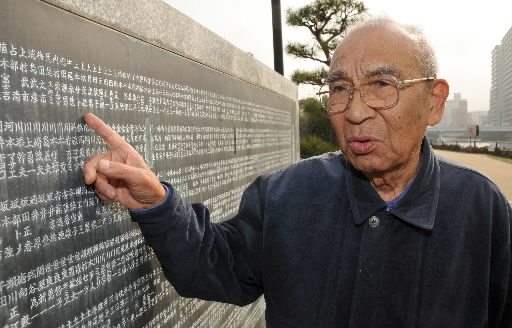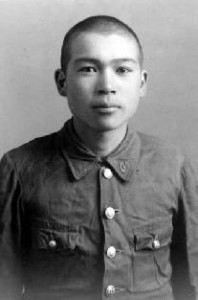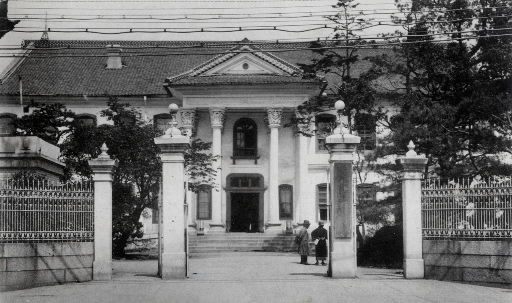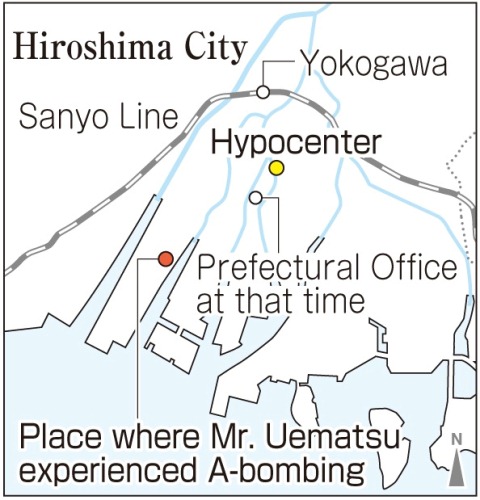Toshiro Uematsu, 84, Aki Ward, Hiroshima
Feb. 18, 2014
Father was never found
Searched for his father, day after day
“Dad, everything is going well for me.” Every year on August 6, the anniversary of the atomic bombing, Toshiro Uematsu, 84, visits the monument dedicated to civil servants of Hiroshima Prefecture who perished that day, located in Naka Ward, and speaks to his father Mitsuo, who died at the age of 51.
When the atomic bomb was dropped on August 6, 1945, Mr. Uematsu was 15 years old, a fourth-year student at First Hiroshima Prefectural Junior High School (now Kokutaiji High School). In the middle of July 1945, his mother, two younger sisters, and a younger brother evacuated the city and went to stay on the outskirts of town. Mr. Uematsu continued to live with his father, a prefectural official, in their house in Nihocho (part of today’s Minami Ward).
On August 6, Mr. Uematsu was working at an arsenal in Minamikannoncho (part of present-day Nishi Ward), where he had been mobilized for the war effort. It was located about 3.5 kilometers from the hypocenter. Suddenly, there was a flash overhead. “Get down!” someone cried. When Mr. Uematsu raised his head and stood, he discovered that he had been blown off his feet by about five meters. He suffered a gash to his right arm that took about a month to heal.
He was told to move to an air-raid shelter and count heads there, then he was allowed to return home. Along the way, he saw people burned by the bomb who were fleeing the city center, and this made him anxious for his father’s safety. The night before, on August 5, his father had stayed to work at the Prefectural Office, located in Kakomachi (part of today’s Naka Ward). Mr. Uematsu tried heading toward Kakomachi, but had to abandon the idea when he was met with raging flames.
That evening, after taking a detour, he finally arrived home. His father, however, wasn’t there. He then went to where his mother and his siblings were staying outside the city, but they had no news of his father, either. From the next day, August 7, he began a daily search for his father, visiting the Hiroshima Red Cross Hospital (in today’s Naka Ward) and the wreckage of the Prefectural Office. Recalling that time, he choked back tears and said, “As a last hope, I went to the relief station on Ninoshima Island, but his name wasn’t on the list. I was in despair and I just couldn’t bear it.”
On September 6, at a temporary site for the Prefectural Office in Toyo Kogyo (today’s Mazda, an automobile manufacturer in Fuchu), a memorial service was held for the victims. Because his father was a large man, Mr. Uematsu was told that “bigger bones were chosen” and his family received these remains. According to colleagues who survived the bombing, they learned that, at 8 a.m. that morning, just prior to the blast, his father was in his department, the Welfare Division. That was all the family could glean about what had happened to him.
After the loss of his father, Mr. Uematsu faced a series of hardships. He gave up his dream of attending college to become a teacher, and, instead, took a position at the Prefectural Office and worked hard to support the family. When his mother came down with tuberculosis, they had to sell their home in order to afford costly medicine.
He was wed in 1956, and has two children and four grandchildren. Throughout his life, he has kept in mind his father’s words, “Be kind to everyone.” Following this principle, after retiring he has been an active volunteer, serving the people in his local community and teaching Japanese to people from other countries. He appeals to today’s youth: “Despite our differences as nations, I hope you will interact with others as members of the same human family. War must never be waged.” (Sakiko Masuda, Staff Writer)
Hiroshima Prefectural Office: Blown down and burned, a total of 1,141 victims
At the time of the atomic bombing, the Hiroshima Prefectural Office was located in Kakomachi (part of present-day Naka Ward). The wooden building, constructed in the Meiji Era (1868-1912), lay only about 900 meters from the hypocenter, and so was blown down and burned. Most of the workers there were killed instantly or burned to death under the wreckage of the building.
According to the prefectural government, a total of 1,142 civil servants fell victim to the atomic bomb, including workers in other offices and those who were on their way to work that morning. Notes written by a worker who visited the rubble of the Prefectural Office in the aftermath describe the cruel scene: “There are charred bodies here and there. Making guesses based on the position of the desks, I picked up bones and placed them into envelopes, writing each person’s name on them.”
In the evening of August 6, the Prefectural Office and its operations were moved to Tamonin Temple on the western side of Mt. Hijiyama and on August 7, again shifted to the Higashi Police Station in Shimoyanagicho (present-day Kanayamacho, Naka Ward). From August 20, a portion of Toyo Kogyo (today’s Mazda Motor Corporation, in Fuchu Town) was used as a temporary site, then from July 1946, the former Hiroshima Army Ordnance Supply Depot became the Prefectural Office building. In 1956, it was moved to its current location in Motomachi, Naka Ward.
A monument was raised on the site where the former Prefectural Office, destroyed in the A-bombing, once stood.
Teenagers’ Impressions
Robbed of loved ones in an instant
I won’t forget the sight of Mr. Uematsu choking back tears as he talked about his father. Each year he visits the monument dedicated to the memory of the Hiroshima prefectural workers who died in the bombing, to tell his father that he’s doing fine. It made me feel, again, how cruel the atomic bomb was, robbing people of loved ones in an instant. I want to cherish the time I spend with my parents. (Kantaro Matsuo, 15)
Heart ached for his distress
After the bombing, Mr. Uematsu was searching desperately for his father, walking through the scorching heat. He wasn’t able to find him, however. My heart ached for him, imagining his distress. Following his father’s words, “Be kind to everyone,” he has valued his interactions with others, such as teaching Japanese to people from other countries. I want to learn from his example. (Risa Murakoshi, 17)
Staff Writer’s Notebook
After the bombing, Mr. Uematsu searched for his father, day after day, but wasn’t able to find him. The Prefectural Office, where his father worked, was located just 900 meters from the hypocenter. Mr. Uematsu went to the site, but the building had burned to the ground, leaving little behind. At Hiroshima Red Cross Hospital, the faces of the injured were swollen and Mr. Uematsu was unable to distinguish one from the next. He moved about, shouting, “Have you seen Uematsu?”
Two of his father’s colleagues, who worked with him in the Welfare Division, managed to survive the bombing. They told Mr. Uematsu that his father was in their office at 8 a.m. that day. These two colleagues, however, passed away just days later.
The Prefectural Office suffered a terrible death toll that day, with most of its workers inside the building perishing in the blast. Mr. Uematsu believes that his father was killed instantly. This year will mark the 69th anniversary of the atomic bombing. Every year, on August 6, Mr. Uematsu visits the monument for the victims of the Prefectural Office and thinks of his father. (Sakiko Masuda)
(Originally published on February 10, 2014)
Searched for his father, day after day
“Dad, everything is going well for me.” Every year on August 6, the anniversary of the atomic bombing, Toshiro Uematsu, 84, visits the monument dedicated to civil servants of Hiroshima Prefecture who perished that day, located in Naka Ward, and speaks to his father Mitsuo, who died at the age of 51.
When the atomic bomb was dropped on August 6, 1945, Mr. Uematsu was 15 years old, a fourth-year student at First Hiroshima Prefectural Junior High School (now Kokutaiji High School). In the middle of July 1945, his mother, two younger sisters, and a younger brother evacuated the city and went to stay on the outskirts of town. Mr. Uematsu continued to live with his father, a prefectural official, in their house in Nihocho (part of today’s Minami Ward).
On August 6, Mr. Uematsu was working at an arsenal in Minamikannoncho (part of present-day Nishi Ward), where he had been mobilized for the war effort. It was located about 3.5 kilometers from the hypocenter. Suddenly, there was a flash overhead. “Get down!” someone cried. When Mr. Uematsu raised his head and stood, he discovered that he had been blown off his feet by about five meters. He suffered a gash to his right arm that took about a month to heal.
He was told to move to an air-raid shelter and count heads there, then he was allowed to return home. Along the way, he saw people burned by the bomb who were fleeing the city center, and this made him anxious for his father’s safety. The night before, on August 5, his father had stayed to work at the Prefectural Office, located in Kakomachi (part of today’s Naka Ward). Mr. Uematsu tried heading toward Kakomachi, but had to abandon the idea when he was met with raging flames.
That evening, after taking a detour, he finally arrived home. His father, however, wasn’t there. He then went to where his mother and his siblings were staying outside the city, but they had no news of his father, either. From the next day, August 7, he began a daily search for his father, visiting the Hiroshima Red Cross Hospital (in today’s Naka Ward) and the wreckage of the Prefectural Office. Recalling that time, he choked back tears and said, “As a last hope, I went to the relief station on Ninoshima Island, but his name wasn’t on the list. I was in despair and I just couldn’t bear it.”
On September 6, at a temporary site for the Prefectural Office in Toyo Kogyo (today’s Mazda, an automobile manufacturer in Fuchu), a memorial service was held for the victims. Because his father was a large man, Mr. Uematsu was told that “bigger bones were chosen” and his family received these remains. According to colleagues who survived the bombing, they learned that, at 8 a.m. that morning, just prior to the blast, his father was in his department, the Welfare Division. That was all the family could glean about what had happened to him.
After the loss of his father, Mr. Uematsu faced a series of hardships. He gave up his dream of attending college to become a teacher, and, instead, took a position at the Prefectural Office and worked hard to support the family. When his mother came down with tuberculosis, they had to sell their home in order to afford costly medicine.
He was wed in 1956, and has two children and four grandchildren. Throughout his life, he has kept in mind his father’s words, “Be kind to everyone.” Following this principle, after retiring he has been an active volunteer, serving the people in his local community and teaching Japanese to people from other countries. He appeals to today’s youth: “Despite our differences as nations, I hope you will interact with others as members of the same human family. War must never be waged.” (Sakiko Masuda, Staff Writer)
Hiroshima Insight
Hiroshima Prefectural Office: Blown down and burned, a total of 1,141 victims
At the time of the atomic bombing, the Hiroshima Prefectural Office was located in Kakomachi (part of present-day Naka Ward). The wooden building, constructed in the Meiji Era (1868-1912), lay only about 900 meters from the hypocenter, and so was blown down and burned. Most of the workers there were killed instantly or burned to death under the wreckage of the building.
According to the prefectural government, a total of 1,142 civil servants fell victim to the atomic bomb, including workers in other offices and those who were on their way to work that morning. Notes written by a worker who visited the rubble of the Prefectural Office in the aftermath describe the cruel scene: “There are charred bodies here and there. Making guesses based on the position of the desks, I picked up bones and placed them into envelopes, writing each person’s name on them.”
In the evening of August 6, the Prefectural Office and its operations were moved to Tamonin Temple on the western side of Mt. Hijiyama and on August 7, again shifted to the Higashi Police Station in Shimoyanagicho (present-day Kanayamacho, Naka Ward). From August 20, a portion of Toyo Kogyo (today’s Mazda Motor Corporation, in Fuchu Town) was used as a temporary site, then from July 1946, the former Hiroshima Army Ordnance Supply Depot became the Prefectural Office building. In 1956, it was moved to its current location in Motomachi, Naka Ward.
A monument was raised on the site where the former Prefectural Office, destroyed in the A-bombing, once stood.
Teenagers’ Impressions
Robbed of loved ones in an instant
I won’t forget the sight of Mr. Uematsu choking back tears as he talked about his father. Each year he visits the monument dedicated to the memory of the Hiroshima prefectural workers who died in the bombing, to tell his father that he’s doing fine. It made me feel, again, how cruel the atomic bomb was, robbing people of loved ones in an instant. I want to cherish the time I spend with my parents. (Kantaro Matsuo, 15)
Heart ached for his distress
After the bombing, Mr. Uematsu was searching desperately for his father, walking through the scorching heat. He wasn’t able to find him, however. My heart ached for him, imagining his distress. Following his father’s words, “Be kind to everyone,” he has valued his interactions with others, such as teaching Japanese to people from other countries. I want to learn from his example. (Risa Murakoshi, 17)
Staff Writer’s Notebook
After the bombing, Mr. Uematsu searched for his father, day after day, but wasn’t able to find him. The Prefectural Office, where his father worked, was located just 900 meters from the hypocenter. Mr. Uematsu went to the site, but the building had burned to the ground, leaving little behind. At Hiroshima Red Cross Hospital, the faces of the injured were swollen and Mr. Uematsu was unable to distinguish one from the next. He moved about, shouting, “Have you seen Uematsu?”
Two of his father’s colleagues, who worked with him in the Welfare Division, managed to survive the bombing. They told Mr. Uematsu that his father was in their office at 8 a.m. that day. These two colleagues, however, passed away just days later.
The Prefectural Office suffered a terrible death toll that day, with most of its workers inside the building perishing in the blast. Mr. Uematsu believes that his father was killed instantly. This year will mark the 69th anniversary of the atomic bombing. Every year, on August 6, Mr. Uematsu visits the monument for the victims of the Prefectural Office and thinks of his father. (Sakiko Masuda)
(Originally published on February 10, 2014)











